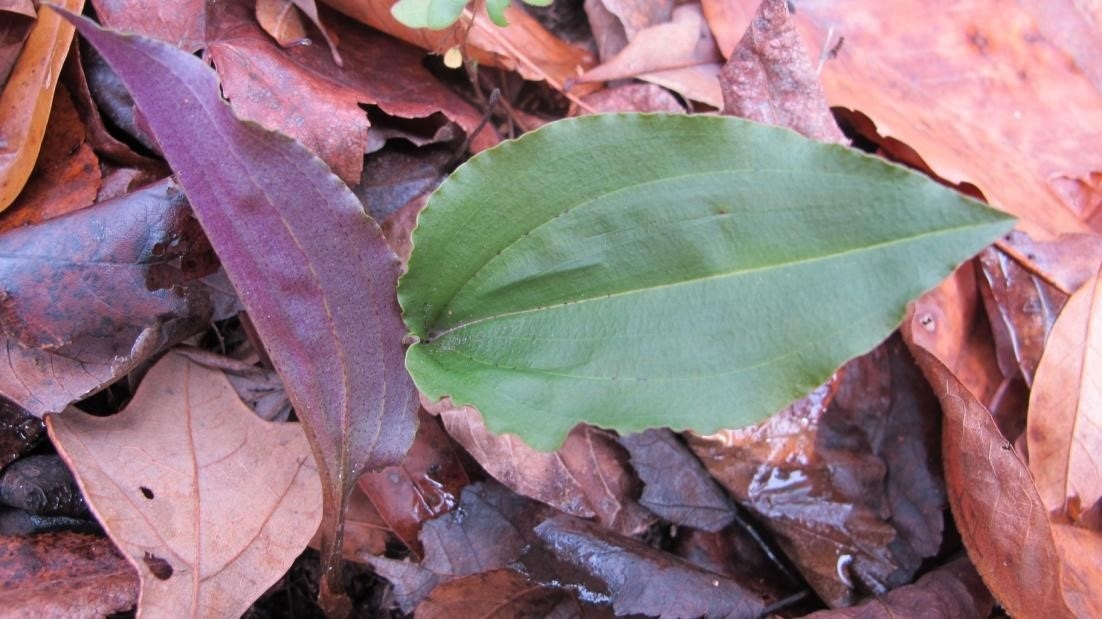As fall approaches and the growing season winds down, many trees and plants produce fruits and seeds that will sprout and grow in the spring. The nuts and berries are also eaten or collected and stored by birds and wildlife to prepare for the coming winter. Birds that migrate in the fall must bulk up their fat stores with the abundant seeds and fruits to fuel their flight. Squirrels and chipmunks race around collecting acorns and other nuts to store for the winter.
At Deep Run Park walk around the biking/hiking train that follows the perimeter of the park. See if you can find some of the following:
1. Bright red berries embedded in a carpet of green plants with tiny leaves.
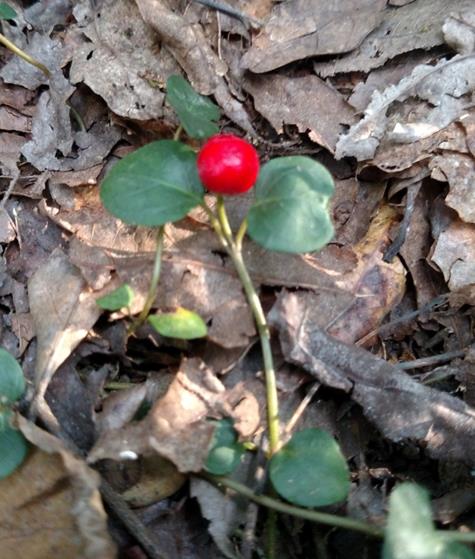
Partridgeberry
This plant is Partridgeberry (Mitchella repens), an evergreen plant that creeps along the ground forming a green carpet in wooded areas. In the spring it produces pairs of small white flowers, but only one red berry develops from the flowers. September is the ideal month to find the berries. Once leaves begin to fall, Partridgeberry is covered up and can remain hidden until spring.

2. Green shrub with interesting orange berries hanging from magenta colored caps.
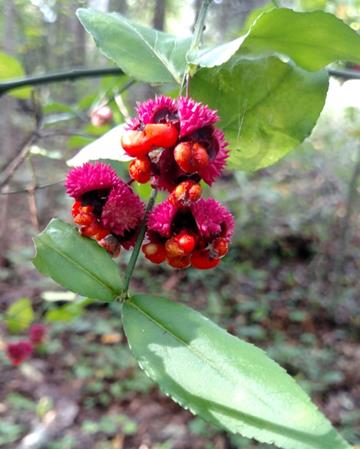
Hearts-a-Bustin or Strawberry Bush
The Strawberry Bush sometimes referred to as Hearts-a-Bustin (Euonymus americanus) is a common shrub in Deep Run Park, but most of the year you hardly notice it. It is a leggy bush with dark green stems. Deer find this native shrub quite tasty and will munch it so much that it does not always have the energy to produce fruit. But there is are usually enough of these shrubs in the woods so that some of them grow the striking berries. The beautiful fruit begins to ripen in early fall. Initially the fruits are closed pink capsules that darken in color and split open to reveal their bright orange berries.
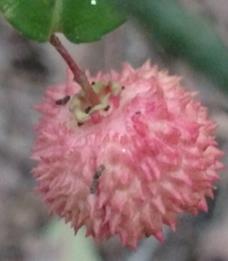
3. Acorns.
September is also the best time to look for acorns. Each species of oak has a distinctive acorn. Look at the size and shape of the acorn. How much of the acorn is encased in the cap? How many different varieties of acorn can you find?
Can you match the acorn with a leaf from the tree on which the acorn fell?
Three common oaks in Deep Run Park are White Oak (Quercus alba)
https://dendro.cnre.vt.edu/dendrology/syllabus/factsheet.cfm?ID=35, Northern Red Oak (Quercus rubra)
https://dendro.cnre.vt.edu/dendrology/syllabus/factsheet.cfm?ID=38 , and Southern Red Oak (Quercus falcata) https://dendro.cnre.vt.edu/dendrology/syllabus/factsheet.cfm?ID=68.
See also Common Native Trees of Virginia: Tree Identification Guite. Virginia Department of Forestry. http://www.dof.virginia.gov/infopubs/Native-Tree-ID_2016_pub.pdf
4. Small nuts (1-2 in. long) with a very hard shell.
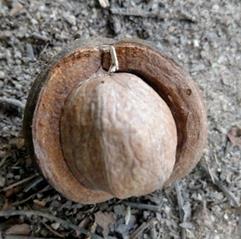
Mockernut Hickory nut in husk
These are hickory nuts. The Mockernut Hickory (Carya alba) is the most abundant hickory in Deep Run Park. The nuts have a very thick, leathery husk that splits open when ripe revealing the hard-shelled nut that resembles a very small walnut. Deer, squirrels, rabbits, and mice relish these nuts. They are quite tasty to us as well once you crack it open (with a rock or hammer on a flat rock). The nut meat is very small and might require a nut pick to get it out of the shell, but success yields a nut that resembles a pecan in flavor.
The Mockernut Hickory has compound leaves with 7-9 leaflets. When crushed the leaves have a very pleasant smell.
Not all hickory nuts taste as good. The aptly named Bitternut Hickory (Carya cordiformis) also has compound leaves with 7-11 leaflets, but the nuts are thin shelled and bitter.
The Pignut Hickory occurs less frequently in Deep Run Park. Only 5 leaflets make up its compound leaf. The nuts are thinner-shelled and can be bitter.
Common Native Trees of Virginia. Virginia Department of Forestry, pages 43, 41 and 44.
http://www.dof.virginia.gov/infopubs/Native-Tree-ID_2016_pub.pdf
As you complete your walk on the biking and hiking path around the park, how many plants with red berries did you see?
Did you find Strawberry Bush fruit? Were the fruits pink and just ripening or fully open with orange fruits hanging from the caps?
How many kinds of acorns did you find? Could you match them with the oak leaf from the tree?
Did you find any hickory nuts? They don’t stay on the ground long before the squirrels and other wildlife find them. If you found any, did you try to crack them open?






